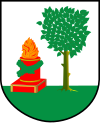Biała Piska
| Biała Piska | ||
|---|---|---|
|
||
| Coordinates: 53°37′N 22°4′E / 53.617°N 22.067°E | ||
| Country |
|
|
| Voivodeship | Warmian-Masurian | |
| County | Pisz | |
| Gmina | Biała Piska | |
| Established | 15th century | |
| Town rights | 1722 | |
| Government | ||
| • Mayor | Ryszard Sławomir Szumowski | |
| Area | ||
| • Total | 3.24 km2 (1.25 sq mi) | |
| Population (2006) | ||
| • Total | 4,006 | |
| • Density | 1,200/km2 (3,200/sq mi) | |
| Time zone | CET (UTC+1) | |
| • Summer (DST) | CEST (UTC+2) | |
| Postal code | 12-230 | |
| Area code(s) | +48 87 | |
| Car plates | NPI | |
| Website | http://bip.bialapiska.pl | |
Biała Piska [ˈbʲawa ˈpʲiska] (German: Gehlen, later Bialla, 1938-1945 Gehlenburg) is a town in Pisz County, Warmian-Masurian Voivodeship, Poland, with 4,036 inhabitants (2004).
Biała Piska is a recreation area in the Masurian Lake District, located in the eastern part of the Warmian-Masurian Voivodeship, on the east coast of Śniardwy, the largest of the lakes. To the south is the Puszcza Piska, a heath with large forests. It is situated at the intersection of Highways 16 (Olsztyn-Ełk) and 58 (Szczytno–Grajewo).
The town was established in 1428 as a German farming village "Auf der Gaylen", in the monastic state of the Teutonic Knights. In 1480 a church was built there. In the 16th century it grew rapidly in the Duchy of Prussia, as trading increased between the Germans and Poles. In the middle of the century there were 38 farms and three mills. In 1645 it gained the right to have four markets per year. In 1656 it was pillaged by the Tatars, plundered and burned, and many residents died or were displaced. It became part of the Kingdom of Prussia in 1701.
From 1709-1711, there was a plague epidemic, which killed 315 residents. Nonetheless, the economic development continued apace, and the settlement received its town charter in 1722 from King Frederick William I of Prussia. A royal resettlement program brought many new residents, especially artisans. Between 1756 and 1763, a new church, a 1.65 ha marketplace, a network of roads, and a new town hall were built. During the Seven Years' War, the town was occupied by Russian troops from 1758-1762. Afterwards, it became a garrison city for Prussian troops from 1764 to 1800.
...
Wikipedia


